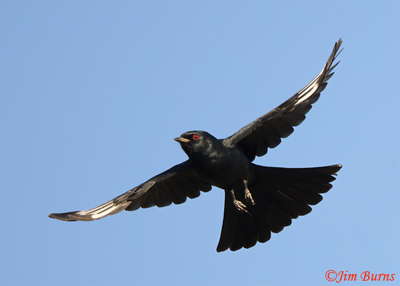
First in are Lesser Goldfinches and House Finches, their yellows and reds gleaming gold and scarlet respectively, as the sun finally clears the last rocky parapets behind me to the east. Next come a flock of twenty bluebirds, westerns, their muted chestnuts glowing orange against the dark wood, their deep blues iridescent as they fluff and huddle against the cold like plump, feathery little pillows arranged in adjacent rows.
And then two outliers rise up from the riparian corridor below, so unexpected I must raise my binoculars for the first time to confirm my suspicion. Cedar Waxwings! The bosque mesquites are filling up now, quite literally, with the waxwings’ “silky” cousins, the Phainopeplas. I do a quick, 360 degree inventory, and count seventeen “desert cardinals”--males, females, probably some juveniles, a few atop the magic tree itself, squabbling over perches and sallying skyward, seemingly by turn, to take insects rising in the warming thermals.
But, waxwings! I haven’t seen a Cedar Waxwing in Arizona for several years, and I have no idea the reason why--wrong place, wrong time, uncommon bird? “Silky” never comes to mind when I see a waxwing. For me they are “velvet,” and these two are velvet gold in the dawn’s early light. I suppose, if you discount the twenty years between the Cedar Waxwings I remember as a toddler’s first birds with a named name and the time I actually became a birder, then waxwings were my spark bird.
There’s something about birds with crests and birds with masks that gives pause, even to the uninitiated, and Cedar Waxwings check both those boxes. And the small but riveting touches of color on wing and tail, even without the beautiful underparts, easily trump our black cardinals’ scarlet eyes. I’ve yet to capture the photo cliché of waxwings passing winter berries down a lineup on a snowy branch, though I have caught single birds with fruit in beak.
The ancient mesquite hosts a few clumps of mistletoe, and as sunlight slowly warms the scene, the bluebirds avail themselves of the waxy, white berries. I am hopeful the waxwings will follow suit as the number of species doing so has now exceeded a dozen as I watch transfixed—both Gila and Ladder-backed Woodies, and flickers, both Northern and Gilded, Verdins, thrashers, mockingbirds, and of course the ground gleaners under the tree, Abert’s Towhees, White-crowned and Lark Sparrows.
I glance up again to discover the waxwings have departed for parts unknown, and the bluebirds soon follow, dispersing out across the mesquite tablelands above the river. I walk a mile upstream in the warming sun under now azure skies. From the river to the mountains the Tonto is a vast expanse and two waxwings like two islands on an ocean. I find several mistletoe host trees, but with only Phainopeplas attendant.
Tomorrow I know I’ll be in attendance again at the sentinel mesquite, waiting in the cold gray light of our Sonoran desert.